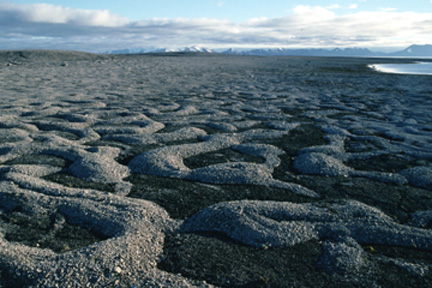Geotimes

News Notes
Geomorphology
Stone patterns
 Many
patterns in an otherwise chaotic world sport explanations for their existence
that are now taken almost for granted. Build up of sediment directs a river
to meander; wind carrying capacity shifts sand dunes grain by grain across a
desert. But the idea that physical laws acting on individual particles can explain
the Mississippi River’s flow or the Sahara’s changing hillsides is
falling out of favor. In its place is the concept that mountains, rivers, deserts
and the geomorphology of our planet are self-organizing in a way that incorporates
multiple processes that can only be understood when looked at from a variety
of perspectives.
Many
patterns in an otherwise chaotic world sport explanations for their existence
that are now taken almost for granted. Build up of sediment directs a river
to meander; wind carrying capacity shifts sand dunes grain by grain across a
desert. But the idea that physical laws acting on individual particles can explain
the Mississippi River’s flow or the Sahara’s changing hillsides is
falling out of favor. In its place is the concept that mountains, rivers, deserts
and the geomorphology of our planet are self-organizing in a way that incorporates
multiple processes that can only be understood when looked at from a variety
of perspectives.
In the Jan. 17 Science, Mark Kessler and Brad Werner expand
on this idea to explain how the seasonal cycles of freezing and thawing create
circles, polygons and labyrinths of stones and soil patterns across the Arctic
landscape. Their numerical model considers individual grain sorting as well
as the behavior of the feature as a whole under freezing and thawing conditions.
They identified feedback mechanisms that move soil toward soil and stones toward
stones. Over time, these mechanisms accumulate soils and stones into distinct
grouping patterns. “Labyrinths are formed when the stone to soil ratio
is low compared to in sorted circles,” Kessler says. When a sloped hillside
is brought into the equation, the labyrinths will stretch out forming stripes.
Pictured here are formations found in Kvadehuksletta on the western Spitsbergen
Island in Svalbard, Norway. Photo by Mark Kessler.
Christina Reed
 Many
patterns in an otherwise chaotic world sport explanations for their existence
that are now taken almost for granted. Build up of sediment directs a river
to meander; wind carrying capacity shifts sand dunes grain by grain across a
desert. But the idea that physical laws acting on individual particles can explain
the Mississippi River’s flow or the Sahara’s changing hillsides is
falling out of favor. In its place is the concept that mountains, rivers, deserts
and the geomorphology of our planet are self-organizing in a way that incorporates
multiple processes that can only be understood when looked at from a variety
of perspectives.
Many
patterns in an otherwise chaotic world sport explanations for their existence
that are now taken almost for granted. Build up of sediment directs a river
to meander; wind carrying capacity shifts sand dunes grain by grain across a
desert. But the idea that physical laws acting on individual particles can explain
the Mississippi River’s flow or the Sahara’s changing hillsides is
falling out of favor. In its place is the concept that mountains, rivers, deserts
and the geomorphology of our planet are self-organizing in a way that incorporates
multiple processes that can only be understood when looked at from a variety
of perspectives.
